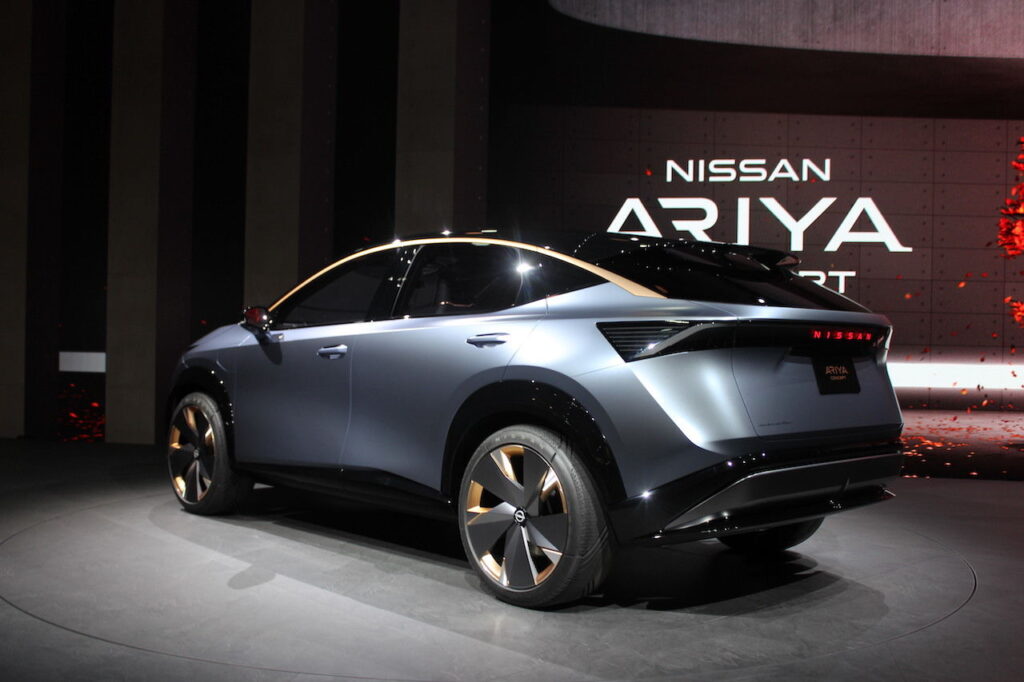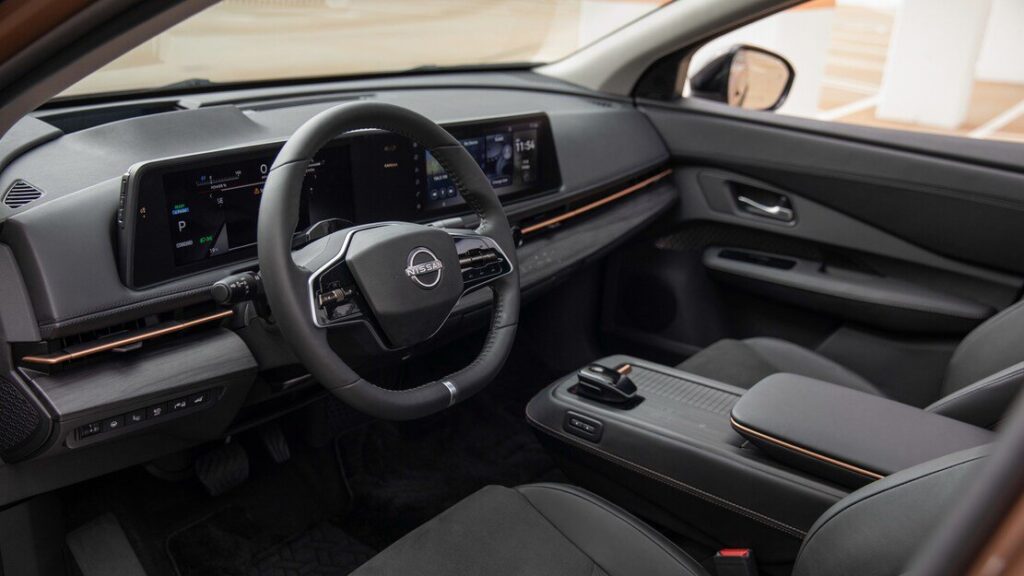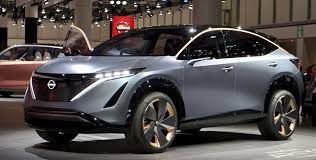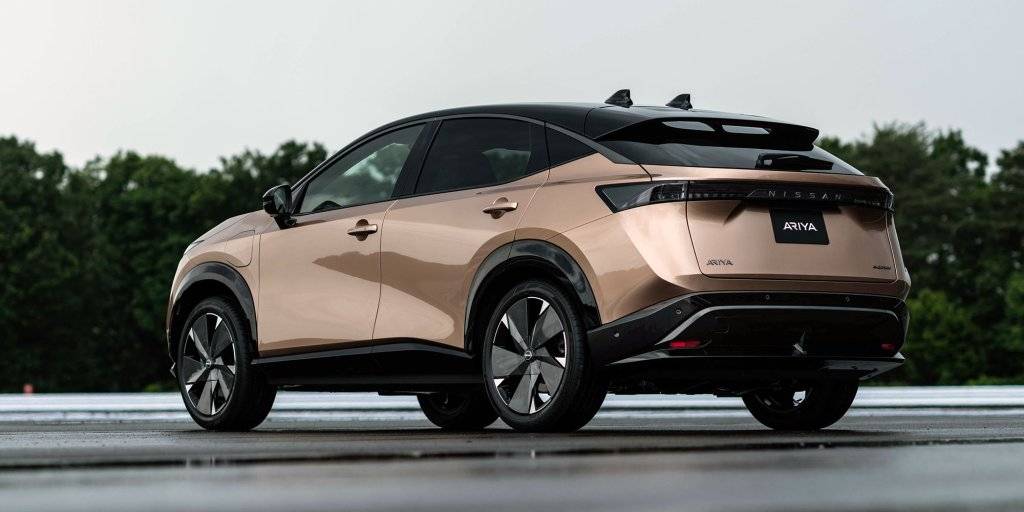The Nissan Ariya stands at the vanguard of electric innovation, embodying Nissan’s commitment to redefining the future of mobility. As an all-electric SUV, the Ariya represents a bold leap towards sustainable transportation, seamlessly blending cutting-edge technology, sleek design, and an eco-conscious ethos in a vehicle designed to set new standards in the electric vehicle landscape.
Nissan, as the manufacturer of the Ariya, has showcased immense enthusiasm and confidence in this electric SUV. The company sees the Ariya as a pivotal offering in their lineup, embodying their commitment to innovation, sustainability, and future-forward design.
Nissan’s statements and promotional materials often emphasize the Ariya’s technological advancements, its sleek and aerodynamic design, and the integration of user-friendly, cutting-edge features. The company appears to be positioning the Ariya as a flagship electric vehicle, showcasing Nissan’s dedication to electric mobility and their vision for the future of driving.
Their narrative revolves around the Ariya being more than just a vehicle; it’s a statement of Nissan’s technological prowess and commitment to a greener future. Nissan has expressed a strong belief in the Ariya’s potential to capture the market’s attention and be a key player in the electric vehicle landscape.
Consumer opinions about the Nissan Ariya were largely positive, reflecting anticipation and excitement for its release.
Many prospective buyers were drawn to its sleek design, spacious interior, advanced technology features, and the promise of all-electric driving with an impressive range. The Ariya’s blend of performance, practicality, and eco-friendliness appealed to consumers looking for a versatile electric vehicle in the SUV category.
However, it’s essential to note that opinions can vary among consumers based on individual preferences and experiences. Some potential concerns or criticisms might have revolved around factors such as charging infrastructure, pricing, or specific features, which can differ based on region and personal expectations.

Technical Specifications :
The Nissan Aria comes in two battery and two drive configurations, with a wide range of outputs and ranges available.
The base 66 kWh battery pack (63 kWh usable) with front-wheel drive produces 214 hp and 221 lb-ft and has a range of 216 miles.
The 91kWh package (87kWh usable) boosts power to 238bhp and increases range to 289-304 miles depending on trim.
This car has a small battery model with the e-4ORCE all-wheel drive system, 335 horsepower and 413 lb-ft; But it has the lowest range of 205 miles. Adding the large battery boosts output to 389 horsepower and 442 pound-feet of torque.
In terms of charging speed, the car can be charged at a maximum speed of 130 kW.
Nissan says the Aria can reach maximum charge faster than competitors and hold a charge for longer; So it improves the charging time. A 20-80% charge takes 35-40 minutes (depending on the size of the battery). At home, charging from 0 to 100 percent takes between 10.5 and 14 hours

Beautiful and spacious interior:
Instead of including storage space under the hood that might not be used, Nissan has used that space for the climate control system. This allows engineers to free up space in the cabin.
The layout of the Aria cabin is reminiscent of the BMW iX, and there is very little space between the driver and the passenger. The sliding and electric handle that comes out of the dashboard is great. Nissan says it’s the perfect space to hold your phone for watching movies while charging or doing some work on a tablet or small laptop.
It is also good as a secret storage place for valuables.
Our only complaint about the cabin is the capacitive touch air conditioning controls that sit on the wood trim. These buttons are visually beautiful, but they require pressing and force us to take our eyes off the road.
At the front, the Aria has two 12.3-inch screens, one for the indicators and the other for the infotainment system.
The second display is a new system that includes wireless Apple CarPlay, Amazon Alexa, and Smart Voice Control with a “Hey Nissan” command.
It looks like a big upgrade over Nissan’s previous infotainment system, which we didn’t like because of the split-screen design that won’t be disabled; We criticized it. The user interface has been improved and it is easier to switch between route guidance and audio playback.
The rear seats are spacious and middle passengers can also ride comfortably thanks to the flat floor and sliding center armrest.
Nissan says the trunk has 22.8 cubic feet of space, which is more than the Ioniq 5 and EV6, but less than the Mach-E and ID.4. With the seats folded down, the trunk holds 59.7 cubic feet.

Serious competitors of Nissan Aria:
The Nissan Ariya faces competition from several other electric SUVs and vehicles in the market. Some of its serious competitors include:
- Tesla Model Y: Known for its range, performance, and Tesla’s established Supercharger network.
- Ford Mustang Mach-E: Blending the legacy of the Mustang with electric power, offering performance and style.
- Volkswagen ID.4: Volkswagen’s electric SUV with a balance of range, practicality, and affordability.
- Audi e-tron: Offering luxury and sophistication in an electric SUV package, appealing to those seeking premium features.
- Chevrolet Bolt EUV: A more affordable electric SUV with good range and Chevy’s reputation for reliability.
- Hyundai Ioniq 5: Hyundai’s electric crossover known for its striking design, efficiency, and innovative features.
- BMW iX3 or iX: BMW’s electric SUV lineup, combining BMW’s luxury and performance with electric power.
- Mercedes-Benz EQC: Mercedes’ entry into the electric SUV market, focusing on luxury and comfort.
- Rivian R1S: An up-and-coming electric SUV promising off-road capability and innovative features.
- Lucid Air: While not an SUV, the luxury electric sedan offers impressive performance, range, and cutting-edge technology.
Challenges facing Nissan Aria:
Charging Infrastructure:
- Dependence on Charging Network: The availability and accessibility of charging stations could impact consumer adoption. A robust and widespread charging infrastructure is crucial for all-electric vehicles like the Ariya.
Range Anxiety:
- Range Perception: Overcoming consumer concerns about range anxiety, ensuring that the Ariya’s range is competitive and meets the needs of potential buyers.
Market Competition:
- Competitive Segment: The electric SUV market is becoming increasingly crowded with several strong contenders. Nissan needs to ensure the Ariya stands out among its competitors.
Consumer Education:
- Educating Consumers: Informing potential buyers about the benefits and capabilities of electric vehicles, addressing misconceptions, and showcasing the Ariya’s strengths.
Production and Supply Chain:
- Supply Chain Constraints: Ensuring a smooth production process and managing supply chain challenges to meet the demand for the Ariya without delays or shortages.
Technological Innovation:
- Staying Ahead: Continuous innovation to keep up with, or surpass, technological advancements in the electric vehicle sector.
Cost:
- Competitive Pricing: Balancing affordability while incorporating advanced technology features without significantly increasing the cost for consumers.
Government Policies:
- Regulatory Factors: Adapting to evolving government regulations and policies surrounding electric vehicles, incentives, and infrastructure development.
Brand Perception:
- Shifting Brand Image: Nissan’s brand perception, especially in the realm of electric vehicles, might influence consumer confidence in the Ariya.

Disadvantages and advantages of Nissan Aria:
Advantages:
- Electric Range: Offers a competitive range, providing sufficient mileage for daily use and longer trips.
- Sleek Design: Striking exterior design coupled with a spacious and modern interior, offering a comfortable driving experience.
- Advanced Technology: Incorporates cutting-edge tech features like ProPILOT Assist 2.0 and an extensive infotainment system, enhancing convenience and safety.
- Multiple Trim Options: Available in different configurations, catering to various preferences in terms of power, range, and features.
- Cargo Space: Offers ample cargo space for an SUV, making it practical for everyday use and trips.
- Regenerative Braking: Utilizes regenerative braking, enhancing efficiency and range by capturing energy during deceleration.
Disadvantages:
- Charging Infrastructure: Like many electric vehicles, reliance on a developed charging infrastructure may be a concern for potential buyers.
- Competition: Faces stiff competition in the electric SUV market, requiring standout features to differentiate itself.
- Brand Perception: Nissan’s brand image, especially in the electric vehicle segment, might influence buyer perception compared to more established EV manufacturers.
- Pricing: The cost might be a concern for some consumers, especially when compared to other electric SUVs in a similar price range.
- Performance: While competitive, some models may not match the top-tier acceleration or performance of certain electric vehicles.
- Reliability and Longevity: As a newer model, long-term reliability data might not be readily available, impacting buyer confidence.

Conclusion :
The Nissan Ariya emerges as a compelling entry into the electric SUV market, blending futuristic design, innovative technology, and competitive range to offer a promising alternative for eco-conscious drivers. While facing challenges typical of new entrants in the electric vehicle landscape, such as charging infrastructure and market competition, its sleek aesthetics, advanced features, and varying trim options position it as a contender in the evolving realm of sustainable mobility. With the potential to capture the attention of consumers seeking a harmonious balance of performance, style, and eco-friendliness, the Ariya signifies Nissan’s commitment to shaping the future of electric vehicles while carving its place in an increasingly competitive automotive landscape.
For more information, visit the official website of Nissan Aria.
Read this article : Hyundai Ioniq 6

Leave a Reply